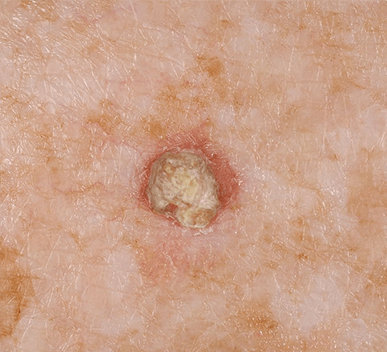Actinic keratosis, also called solar keratosis, is a crusty, scaly growth on the skin. The condition is precancerous. If left untreated, it can develop into a common form of skin cancer, squamous cell carcinoma. Most people who have one actinic keratosis have had enough sun exposure to develop additional, similar lesions. Once you have been diagnosed with a precancerous lesion, it is recommended to follow up closely for skin checks as your dermatologist can diagnose and treat actinic keratoses in the office before they become a skin cancer.
Tues: 8:30am - 3:00pm
Wed: 12:00pm - 6:00pm
Thurs: 8:30am - 3:00pm
Fri: Closed
Sat: 8:30am - 12:30pm
Sun: Closed
Greenvale, NY 11548
Actinic Keratosis


What is actinic keratosis?
What causes actinic keratosis?
Actinic keratosis is caused by skin damaged from exposure to ultraviolet (UV) radiation, both natural sunlight and artificial, such as from a tanning bed. The more time you are exposed to UV rays, the greater the chance you have of developing actinic keratosis. You are at greater risk if you have fair skin, freckles, blonde or red hair and blue, green or gray eyes.
How dermatologists diagnose actinic keratosis
Your dermatologist will often be able to diagnose actinic keratosis simply by examining your skin. It may be necessary to conduct a skin biopsy to confirm the diagnosis. A biopsy is an in-office procedure where your dermatologist will numb the area around the lesion and remove a small skin sample for testing.
How dermatologists treat actinic keratosis
Because there is no way to determine conclusively whether your actinic keratosis will develop into a squamous cell skin cancer, dermatologists routinely recommend treatment of the affected skin. This may be done by a variety of methods depending on many factors including size, location, and number of actinic keratosis.
Cryotherapy (freezing) is the most common treatment. Actinic keratoses are removed from your skin by freezing them with liquid nitrogen. This is an out-patient procedure that does not involve cutting into the skin or stitches.
Photodynamic therapy is an option if you have multiple actinic keratoses. Your dermatologist applies a light-sensitive chemical to your affected skin. The area is exposed to a special light that destroys the actinic keratosis.
Curettage (scraping) of the actinic keratosis is sometimes preformed as another means of treatment. Your dermatologist uses a tool known as a curette to scrape off damaged cells. This is typically followed by electrosurgery, in which your dermatologist destroys the affected tissue with an electric current produced from a thin, pencil-like instrument. You’ll receive a local anesthetic before this procedure.
Topical prescription cream may be prescribed to use at home to treat actinic keratoses. There are several medications that are used including 5-fluorouracil, diclofenac gel, imiquimod cream and ingenol mebutate gel. These topical treatments cause redness, swelling, and crusting at the site of precancerous cells and then healthy skin develops as the treated areas heal.
Even after treatment, your dermatologist will recommend that you have a checkup at least annually for any signs of recurrent or new precancers or skin cancers.
Actinic keratoses are curable if caught early and can prevent developing into skin cancers. If you have a lesion that is concerning for an actinic keratosis, you are encouraged to schedule an appointment with your dermatologist for evaluation.
If you are concerned about actinic keratosis, click here to schedule an appointment with our board-certified dermatologists or walk into Walk-in Dermatology at your convenience for immediate evaluation.






